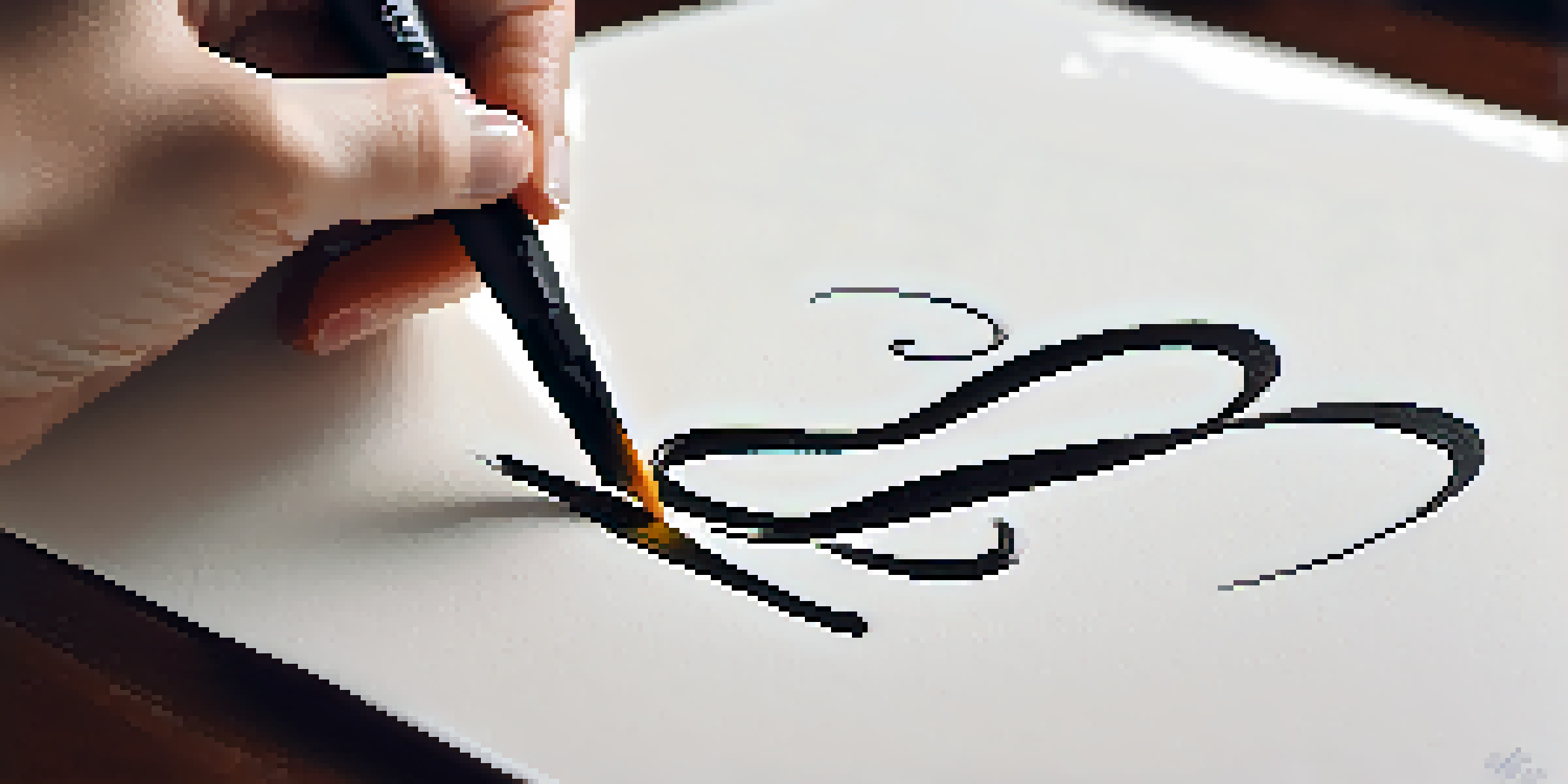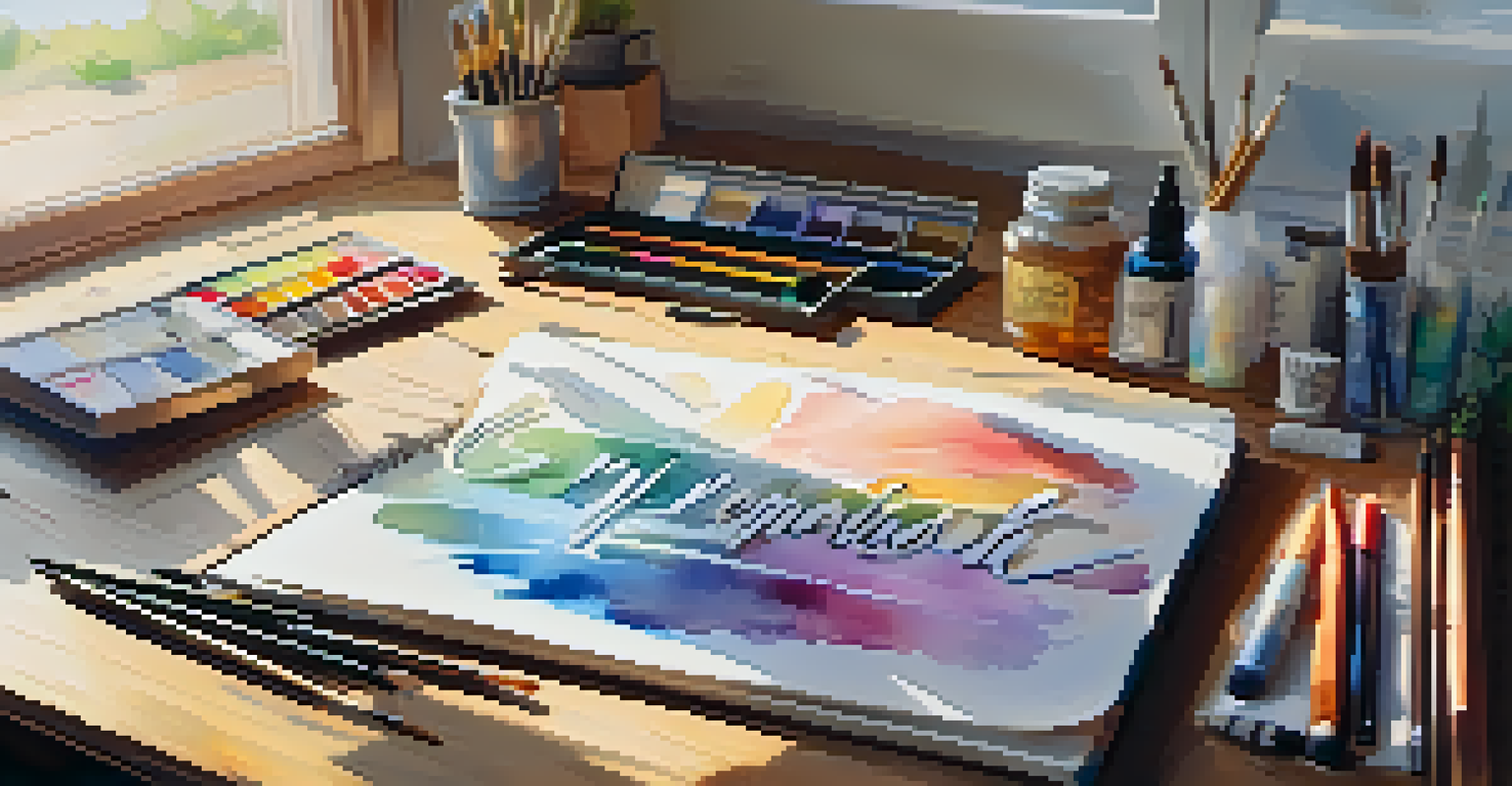The Art of Brush Lettering: Techniques and Tips

Introduction to Brush Lettering: What You Need to Know
Brush lettering is a beautiful art form that combines the fluidity of brush strokes with the elegance of typography. At its core, it’s about creating expressive letters using a brush pen or a paintbrush. Whether you’re a beginner or looking to refine your skills, understanding the basics is essential to mastering this craft.
Creativity takes courage.
This popular technique allows artists to convey emotions through the thickness and thinness of their strokes, creating a dynamic visual experience. Imagine a soft breeze gently flowing through tall grass; that’s the kind of grace you can achieve with brush lettering. It’s not just about making letters; it’s about making a piece of art.
As we explore the techniques and tips throughout this article, remember that practice is key. Just as a musician practices scales, you too will need to devote time to honing your brush lettering skills. Let’s dive into the tools and materials you’ll need to get started!
Essential Tools for Brush Lettering Success
Before you start brush lettering, gathering the right tools can make all the difference. You'll need a good quality brush pen or a set of paintbrushes, along with different types of paper. Think of your tools as the instruments in a band; each one plays a vital role in creating harmony in your lettering.

Brush pens come in various types, from flexible tips to firmer ones, allowing for a wide range of styles. You might also want to experiment with watercolor brushes and inks to add a unique flair to your work. By trying out different tools, you’ll find what feels comfortable and produces the results you desire.
Tools for Brush Lettering Success
Gathering the right tools, like quality brush pens and paper, is essential for creating beautiful brush lettering.
Finally, don’t forget to include a ruler and a pencil for guidelines! These tools help maintain consistent letter heights and spacing, making your letters look more polished. With the right tools in hand, you’re ready to start practicing!
Understanding Basic Brush Lettering Techniques
Brush lettering is all about mastering the basic techniques before moving on to more complex styles. Start by practicing the pressure control that gives each letter its distinctive shape. When you press down on the brush, the stroke will thicken; when you lift it, the stroke will thin out. This is the foundation of brush lettering.
Art is not what you see, but what you make others see.
As you practice, focus on creating smooth, fluid motions. Think of it as dancing with your brush; each stroke should flow into the next with grace. Don’t rush through this process; take your time to develop muscle memory, which will improve your control and precision.
Once you feel comfortable with the basics, try experimenting with different letterforms. Whether you prefer a modern calligraphy style or a more traditional serif, exploring various styles can help you find your unique voice in brush lettering.
Tips for Mastering Letter Forms and Flourishes
As you become more comfortable with brush lettering, you can start adding personal touches like flourishes and embellishments. These elements can elevate your work from simple letters to stunning pieces of art. Think of flourishes as the icing on a cake; they enhance the overall look without overpowering the main structure.
To create beautiful flourishes, practice drawing loops and swirls around your letters. They can be added to the beginning or end of words for a dramatic effect. Just remember to keep it balanced; too many flourishes can make your lettering look cluttered and distracting.
Mastering Techniques is Key
Focusing on pressure control and fluid motions will help you develop the foundational skills necessary for brush lettering.
Additionally, don’t shy away from incorporating different styles of letters within the same piece. Mixing uppercase and lowercase letters or varying the thickness of your strokes adds personality and flair. This playful approach can help you develop a signature style that reflects your artistic voice.
Creating a Consistent Brush Lettering Style
Consistency is key in brush lettering, especially if you aim to develop a recognizable style. One way to achieve this is by practicing the same letter repeatedly until you feel comfortable with its form and flow. This method is similar to a painter mastering a specific brushstroke before applying it to a canvas.
Consider creating a style guide for yourself, where you define the characteristics of your letters, such as slant, size, and spacing. This guide will serve as a reference point for your future work. Having a consistent style not only enhances your skill but also makes your work more cohesive and appealing.
Finally, don’t forget to gather feedback from fellow artists or join a community. Sharing your work and receiving constructive criticism can help you identify areas for improvement and inspire you to grow as a brush lettering artist.
Incorporating Color and Texture into Your Lettering
Adding color and texture to your brush lettering can make your pieces pop and bring them to life. You might start with a monochromatic palette and gradually experiment with gradients or complementary colors. Imagine how a sunset’s vibrant hues can evoke emotion; that’s the kind of impact color can have on your lettering.
To achieve different textures, consider using various brush techniques like wet-on-wet or dry brushing. These methods can add depth and dimension to your work, making it visually engaging. Don't be afraid to mix media, such as incorporating watercolor backgrounds or gold leaf accents to elevate your lettering.
Showcase Your Brush Lettering Art
Sharing your creations through social media and portfolios can inspire others and potentially turn your passion into income.
Experimentation is the name of the game, so play around with different combinations until you find what resonates with you. The beauty of brush lettering is that it allows for endless creativity, so let your imagination run wild!
Showcasing Your Brush Lettering Creations
Once you’ve practiced and developed your brush lettering skills, it’s time to share your creations with the world! Consider starting a social media account dedicated to your artwork, where you can connect with fellow artists and potential clients. This platform allows you to showcase your journey and inspire others along the way.
Creating a portfolio is another great way to present your best work. Whether it’s a digital collection or a physical book, having a portfolio showcases your growth and unique style. It’s like an artist's resume, demonstrating not only your skills but also your passion for the craft.

Finally, consider selling your work through online marketplaces or local craft fairs. Brush lettering can be used for greeting cards, wall art, and more. Sharing your art not only brings joy to others but also allows you to turn your passion into a potential source of income.